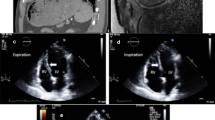Abstract
Objective: To evaluate the risk and effectiveness of pericardiocentesis in primary and repeat cardiac tamponade Design: Retrospective analysis. Setting: Intensive care unit in a medical university hospital. Patients: Sixty-three consecutively admitted patients with cardiac tamponade. Interventions: In all patients pericardiocentesis was performed via the subxiphoid pathway after echocardiographic detection of the pericardial effusion. Measurements and results: There was no adverse event in patients undergoing primary pericardiocentesis, which was sufficient to resolve pericardial effusion in 51 of 63 patients (81 %). However, repeat pericardiocentesis necessitated by the recurrence of symptomatic pericardial effusion yielded suboptimal results in 10 of 12 patients (83 %). Conclusion: Pericardiocentesis is the treatment of choice for primary symptomatic pericardial effusion. In recurrent pericardial effusion surgical approaches appear to be preferable.
Similar content being viewed by others
Author information
Authors and Affiliations
Additional information
Received: 27 August 1999 Final revision received: 18 January 2000 Accepted: 28 February 2000
Rights and permissions
About this article
Cite this article
Bastian, A., Meißner, A., Lins, M. et al. Pericardiocentesis: differential aspects of a common procedure. Intensive Care Med 26, 572–576 (2000). https://doi.org/10.1007/s001340051206
Issue Date:
DOI: https://doi.org/10.1007/s001340051206




